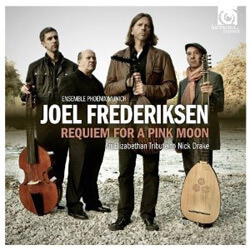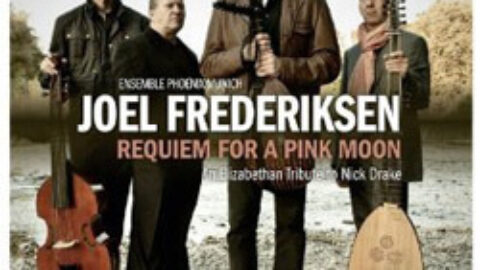 On Joel Frederiksen’s Requiem for a Pink Moon, an Elizabethan Tribute to Nick Drake, selections from a 20th century English songsmith’s sadly truncated canon of music are set alongside that of forebears some 300 years his elder. Pink Moon, Drake’s final and most famous recording, clocks in at under a half hour, yet its realm of influence includes musicians from Robert Smith to Lou Barlow to Mikael Åkerfeldt, and even to the likes of Frederiksen, a bass singer and lutenist who has made a career expertly performing Elizabethan and early baroque music. And while the purest of Drake fans may find themselves irked by how his music sounds in the hands of classically trained period musicians (fans of period music may feel similarly about uncharacteristic 20th century British-folk elements) the record’s beauty lays in the way the songs of each party are left to sit and gaze at one another, elucidating music that seemingly has no business being in the same lineup.
On Joel Frederiksen’s Requiem for a Pink Moon, an Elizabethan Tribute to Nick Drake, selections from a 20th century English songsmith’s sadly truncated canon of music are set alongside that of forebears some 300 years his elder. Pink Moon, Drake’s final and most famous recording, clocks in at under a half hour, yet its realm of influence includes musicians from Robert Smith to Lou Barlow to Mikael Åkerfeldt, and even to the likes of Frederiksen, a bass singer and lutenist who has made a career expertly performing Elizabethan and early baroque music. And while the purest of Drake fans may find themselves irked by how his music sounds in the hands of classically trained period musicians (fans of period music may feel similarly about uncharacteristic 20th century British-folk elements) the record’s beauty lays in the way the songs of each party are left to sit and gaze at one another, elucidating music that seemingly has no business being in the same lineup.

Frederiksen and pretty much anyone else who has come to love Drake’s music did so past the point in which they could hope for any more of it, Drake dying in 1974 at just 26, his fame achieved years later. Michael Cavendish, Thomas Campion, and John Dowland are three British singer-songwriters who have been dead for a lot longer, yet the Elizabethan melancholy offers a direct link between their music and that of Drake, who himself could not have fully expected the sweet sadness that would take precedence in the music he would leave behind.
On Requiem for a Pink Moon, the conceptual dialogue between Drake and his more antique counterparts is connected to that sense of melancholy as well as Frederiksen’s convincing case that pieces of music, despite a large contextual and chronological breach, can inform one another. Arrangements of Drake songs alternate with those of the Dowland and his lot to create thematic pairings, while a setting of the Requiem aeternam is interspersed throughout to guide the material and ground the tribute. A listener can read into these pairings as they see fit or they can simply enjoy the sound of hearing Nick Drake tunes accompanied by some really old instruments. Frederiksen, an accomplished lute player, has here done a rather amazing job of taking the tone clusters born of Drake’s unique guitar tunings and emulating them on period instruments. In general, the musicianship of Frederiksen as well as that of tenor Timothy Leigh Evans, gambist Domen Marincic, and theorbo player and winner of the coolest-name-ever award Axel Wolf shines on Requiem for a Pink Moon and lends credence to what on paper is a bold and curious idea.

Ensemble Munich’s performances would mean little if the music in their hands were not timeless, whether from 1972 or 1672. Part of the joy of Requiem for a Pink Moon lies in how well Drake holds up alongside names one might first learn in a music history class, and conversely how the music behind those dry old names holds up against his, especially in the way they seem to assist in helping to tell his story. Thomas Campion’s “Never weather-beaten sail” features a soothing instrumental introduction as well as a chord progression/hook combo that is catchy whatever the era. Lyrics such as “my wearied spright now longs to flye out of my troubled brest” are relevant to the story of Drake and his amazingly intimate artistic invention. Dowland’s “His golden locks,” which joins a somehow seamless medley alongside Drake’s “Place to Be” is poignant in that stanzas like “O Time too swift! Oh Swiftness never ceasing! His youth ‘gainst Time and Age hath ever spurned,” seem to refer to time that Drake did not have at his disposal. On the other hand, the Drake line “now I’m older, now I’m darker than the deepest sea” reminds us that despite his time running out too quickly, the depths of his music will remain captivating always.
On Dowland’s “Time stands still,” Frederiksen filters Elizabethan music into strummy, folky chimes that aren’t exactly subtle but are eminently refreshing. For those unfamiliar with the Dowland song, to check the liner notes not expecting it to have been composed by a man from the 17th century instills a wonderful feeling of relevance in some very old music. The Frederiksen original “Ocean” is a fitting amalgam of the influences that led to Requiem for a Pink Moon, and it also lends itself to the way in which he took his inspiration and ran with it, tracing Drake’s music to places previously unconsidered. This isn’t to say it always works – the arrangements of Drake’s “Harvest breed,” “Northern Sky,” and even the eponymous “Pink Moon” lack the kind of intimacy and understatement, in part due to the effect of the larger ensemble and in part due to Frederiksen’s own brawny basso profondo, that are so ineffaceable when thinking of the originals. Yet on other songs, like “Place to Be,” “Hanging on a Star,” and “From the Morning” the vocal and instrumental arrangements seem to be infused with Drake’s soul, their subtly effervescent sounds buoyed by the delicate nature of the lute, and their poetry shining in a way that transcends the novel approach to the music.
 In “Which Will” a 24-year-old Nick Drake sings a series of questions that most likely went unanswered in his brief life. In both the Drake original and Frederiksen’s arrangement, there is little that is grave about the music itself, its upbeat trappings making it a celebration of life and the unknown that can seem to be lacking in the work of Drake’s Elizabethan foils. That lesson, like the folky, Drakian giggle played on lute at the conclusion of the record’s final reprise of the Requiem aeternam, offers a rare kind of glimpse of music so often deemed purely melancholic because of its context and its quietude. On Requiem for a Pink Moon, Joel Frederiksen and Ensemble Munich do well to find the bittersweet, but also hope, joy, and life, in music often buried in time and supposed sadness.
In “Which Will” a 24-year-old Nick Drake sings a series of questions that most likely went unanswered in his brief life. In both the Drake original and Frederiksen’s arrangement, there is little that is grave about the music itself, its upbeat trappings making it a celebration of life and the unknown that can seem to be lacking in the work of Drake’s Elizabethan foils. That lesson, like the folky, Drakian giggle played on lute at the conclusion of the record’s final reprise of the Requiem aeternam, offers a rare kind of glimpse of music so often deemed purely melancholic because of its context and its quietude. On Requiem for a Pink Moon, Joel Frederiksen and Ensemble Munich do well to find the bittersweet, but also hope, joy, and life, in music often buried in time and supposed sadness.
Ensemble Phoenix Munich, Joel Frederiksen, Requiem for a Pink Moon (Harmonia Mundi, 2012) | Buy it on Amazon
—
Elias Blumm is a classical guitarist in New York City. Find him on Twitter: @theEelz
























